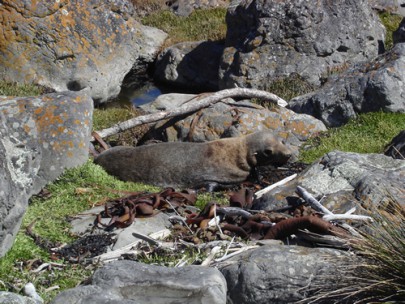Marine mammal haulouts
In this section

Marine mammal haul-out with a New Zealand fur seal at Turakirae Head, southeast of Wellington (Rowan Buxton)
Marine mammal rookeries and haulouts result in coastal areas with soils compacted and enriched by nutrients. Historically, they would have occurred on a wide range of substrates from sand dunes to bedrock, and might have supported quite a wide range of vegetation, as animals inhabited coastal scrub and dune vegetation. However, with the demise of marine mammals from much of the New Zealand coast they are now largely confined to rocky shores with limited friable substrate for plant development, and only low herbs and graminoids are present.
Notable flora and fauna
Threatened and rare plants include the nationally critical coastal peppercress (Lepidium banksii). Nationally vulnerable plants include coastal cress (Lepidium flexicaule), Lepidium naufragorum, Cook’s scurvy grass (Lepidium oleraceum), and New Zealand water cress (Rorippa divaricata), recovering plants include Chatham Island speargrass (Aciphylla traversii), and relict plants include orache (Atriplex australasica), and Chatham Island button daisy (Leptinella featherstonii). Naturally uncommon plants include Buchanan’s orache (Atriplex buchananii), Senecio carnosulus, Senecio marotiri, Mokohinau groundsel (Senecio repangae subsp. pokohinuensis), and Senecio repangae subsp. repangae. Vagrant plants include Senecio australis.
Threatened and rare fauna include the Fiordland skink (Oligosoma acrinasum).
Threat status
Critically endangered (Holdaway et al. 2012)
Threats
Enhanced fertility encourages weed invasion, although this probably does not threaten native plants directly because the latter are so sparse due to the impacts of the marine mammals.
Where do they occur?
Haulouts would once have been found along much of the New Zealand coast, as they still are on remote subantarctic Islands. On the mainland they are now restricted to rocky sites occupied by colonies of New Zealand fur seals (Arctocephalus forsteri), which are widely scattered along the coastline, e.g., on the Kaikoura coast, at Cape Foulwind in Westland, and at Cape Palliser in the North Island.
Further reading
Bradshaw CJA, Thompson CM, Davis LS, Lalas C 1999. Pup density related to terrestrial habitat use by New Zealand fur seals. Canadian Journal of Zoology 77: 1579-1586.
Norton DA, Delange PJ, Garnock-Jones PJ, Given DR 1997. The role of seabirds and seals in the survival of coastal plants: lessons from New Zealand Lepidium (Brassicaceae). Biodiversity and Conservation 6: 765-785.

